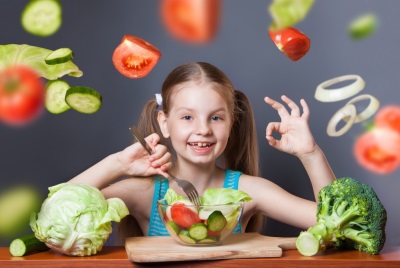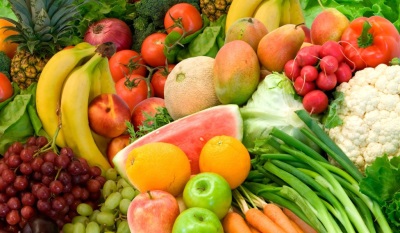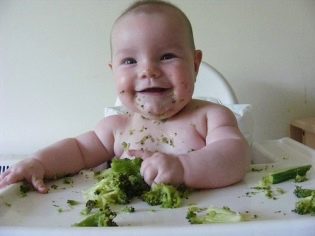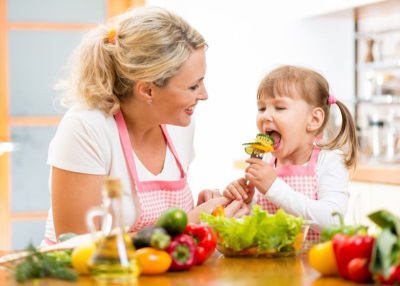What foods can be eaten raw to children and at what age should we start feeding them?
Heat treatment of many products reduces the concentration of vitamins, trace elements and some other substances in their composition. Therefore, any mother of a young toddler, who begins to try complementary foods, wants to give her baby maximum benefit and wonders how long it is acceptable to start giving raw foods to the baby.
What foods give children raw?
In the diet of the child in its raw form can be represented:
- Vegetables. After peeling of seeds and seeds, they are made into salads, filled with vegetable oil or lemon juice. First, the vegetables are rubbed on a fine grater, and a child over 2 years old can be cut into small pieces and seasoned with sour cream.
- Fruits. They appear on the children's menu among the first in the form of applesauce and banana puree. Slices of apple give the child a hand to stimulate chewing from the age of 6-8 months. So that the baby does not choke on a bitten bit by accident, you can use a nibbler.
- Berries. Due to the risk of allergies, their introduction to the children's menu should be very careful. Small children are rubbed through a sieve, ridding the product of bones, peels and dense veins.
Are raw vegetables useful?
Cooking most vegetables leads to the loss of a large number of valuable substances that they contain. For this reason, doctors, among whom is Dr. Komarovsky, are advised to include salads from raw vegetables in the children's diet. However, do not forget about moderation.
Some kids are addicted to raw vegetables and are ready to eat them in large quantities. Sometimes this indicates a lack of vitamins (looking at what kind of vegetable a child prefers, you can understand what the baby lacks) but to avoid excessive consumption of raw vegetables should not be. This will adversely affect intestinal performance and may cause bloating, colic, and stool disorders.
Look, along with the baby, a cartoon in which the Blue Tractor, along with Professor Sour Souley, sings a funny song about the benefits of vegetables:
Much can be said about the benefits of raw vegetables:
- Raw carrots are a source of carotene, pectin, vitamins, fiber and minerals. Such a vegetable is useful for the vision and condition of the skin.
- Raw beets have a high content of iodine, iron and other minerals, as well as vitamin compounds. UhThis raw vegetable strengthens blood vessels and has a positive effect on the blood formula, and also protects the liver and supports metabolic processes.
- Eating raw pumpkin, the child will receive fiber, ascorbic acid, carotene, potassium salts, vitamins of group B and other beneficial substances. This vegetable has a positive effect on the work of the intestines, has an anti-inflammatory effect, and also helps to eliminate cholesterol and toxins.
- Fresh tomatoes give baby beta carotene, B vitamins, potassium, vitamin PP, iodine, iron and many other compounds.. Such vegetables due to pectin, phytoncides and organic acids in their composition have a positive effect on digestion and metabolic processes. It is only important not to forget that they are often allergic, and greenhouse tomatoes are a source of harmful chemicals for children.
- Onions in their raw form are rich in essential oils, minerals, phytoncides, carotene, flavonoids, many vitamins and fiber. It stimulates the appetite and the secretion of gastric juice, thereby normalizing the work of the gastrointestinal tract.
- Raw garlic contains many vitamins, volatile production, trace elements and other useful compounds. It strengthens the defenses of the child’s body, and also has a bactericidal effect.
- Broccoli and Cauliflower useful to eat both boiled and raw. These vegetables help prevent various diseases, including gastrointestinal tract pathologies and cancer. Fresh, these types of cabbage are very tasty and like a lot of kids.
- Raw turnips can be used to prevent constipation. In such a vegetable a lot of ascorbic acid, as well as vitamins PP, B5, A, B2, B1, sulfur, magnesium and phosphorus.
What vegetables are more useful after heat treatment?
Despite all the benefits that have been noted in many raw vegetables, some cultures have a positive effect on the child’s body in boiled, baked or stewed form:
- Beet during heat treatment loses nitrates.
- Baked potatoes It is more useful, so children are not advised to give raw potatoes, just as the product is fried.
- Eggplant after baking, they lose harmful chemicals, and their beneficial properties are more active.
- Asparagus and Tomatoes after heat treatment, they give the child more lycopene and vitamin A.
- Baked or Stewed zucchini contain more vitamin A and folic acid.
From what age do you give raw foods to a child?
A child is introduced to raw vegetables at the age of 1 to 2 years old, carefully observing how the baby’s digestive tract carries such foods raw. A one-year-old child is first given a small amount of raw vegetable, for example, grated raw carrots in a salad. If the crumb has tolerated such a dish well, the volume is gradually increased.
Raw onions, like raw garlic recommended for children not earlier than 3 years of age. Such foods are limited in the children's diet because of their irritant effects on the mucous membranes and rather heavy digestion.
Such raw fruits, as apple, banana and pearappear in the diet of kids before the year. With other fruits and berries in raw form (peaches, grapes, strawberries, plums, apricots, citrus, etc.), the child is introduced after a year.
What products can not be given raw
- Eggs. Eating raw chicken eggs is associated with a high risk of salmonellosis infection. However, in childhood, quail eggs should not be given, because they can cause other diseases on their shells. In addition, raw proteins are hard to digest and can cause diarrhea and flatulence.
- Fish and meat. Such raw materials can be the source of many dangerous pathogens, as well as parasites.
- Mushrooms. They are generally not recommended to be included in the children's diet before school age, but without heat treatment, the use of mushrooms is dangerous and has a negative effect on digestion.
For more information about the lure, refer to the transfer of Dr. Komarovsky.
































































